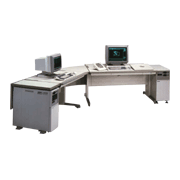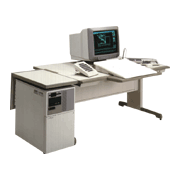This was Fujitsu's first engineering workstation. In 1987, Fujitsu announced two models: the FACOM G-250 (a mass-market model for the engineering workstation field) and the FACOM G-250C (which had world class display processing performance). These machines had the following features:
- High-performance hardware for all-around support of the work of engineers
- Top-class EWS performance was achieved using a built-in high-speed floating point mechanism.
- System performance similar to a host computer was achieved with an proprietary CPU and high-capacity memory.
- The G-250C had a 20-inch bit map display, and achieved world class vector drawing of 200,000 lines per second, and high-speed raster processing performance of 20 million pixels/second.
- Open interface using the SX/G OS conforming to the UNIX System V R2.0
- Support for 26 application packages (primarily CAD related) in the engineering field
- Easy-to-understand man-machine interface and good coordination with host computers
However, U.S. manufacturers had an overwhelming share of the world market in the engineering workstation field. In 1988, Fujitsu began to be supplied with engineering workstations from Sun Microsystems on an OEM basis, and these were commercialized as the FACOM S Family.
| FACOM G-250 | FACOM G-250C | |
|---|---|---|
| Announcement date | June 1987 | |
| CPU | proprietary CPU with 32bit architecture | |
| Main memory | 8-32MB | |
| Built-in file | HD:132MB | |
| (Standard equipment) | 5inch FPD (1MB) 120MB cassette type magnetic tape unit |
|
| Display capabilities |
|
|
| OS | SX/G(UNIX System V R2.0) | |



